Industrial Estates
Lead Pollution
Estimated Population at Risk:
2.9 Million
Description
Industrial Estates are planned, zoned areas that are set aside for a variety of industries, offices, and production. These areas, also known as industrial parks, are frequently built outside of major population areas or residential neighborhoods and are easily accessible via roads, rail, and boat. Industrial estates are often governed by regulatory regimes that are set up to advance and encourage industry. Industrial parks contain a large variety of businesses ranging from food production to heavy metal smelting.
The Multilateral Investment Guarantee Agency of the World Bank recommends that industrial estates have effluent treatment centers, proper infrastructure for containing and disposing of toxic waste, emissions standards, proper monitoring and reporting systems, and clear emergency preparedness plans16. If the proper precautions are taken, industrial estates can reduce community and environmental impacts by isolating potentially hazardous processes in areas far away from residential neighborhoods and by ensuring safety and environmental standards for all of the industries in the zone.
Unfortunately, in many low- and middle-income countries, industrial estates have little to no waste treatment and disposal infrastructure, and they are often located near populated areas. In the case of an industrial estate that has no pollution control mechanisms, lead, which is often a main contaminant caused by industrial estates, can be released into surrounding air, soil, water, and food.
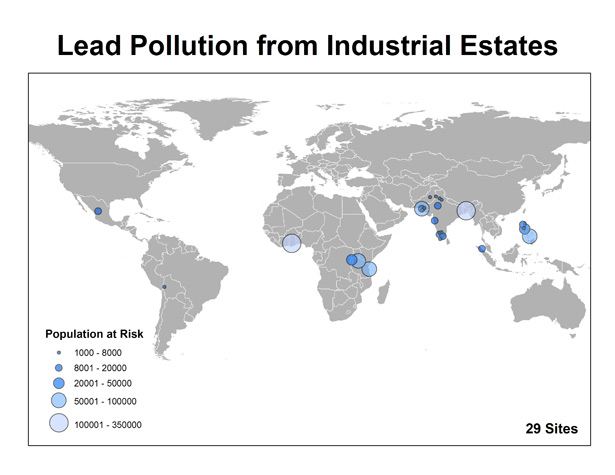
Populations estimates are preliminary and based on an ongoing global assessment of known polluted sites.
Industrial Process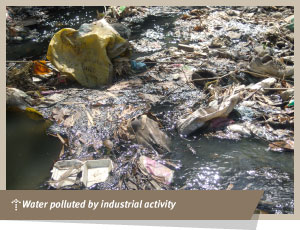 There are a large variety of industries within industrial estates that may be responsible for lead contamination. When industries are located in such close proximity, it is very hard to distinguish which one or ones, in particular, are responsible for pollution. In order to avoid placing blame on the wrong industry, industrial estates are clumped together as one industry group in the Blacksmith inventory, making the isolation of one single lead contamination–causing process impossible.
There are a large variety of industries within industrial estates that may be responsible for lead contamination. When industries are located in such close proximity, it is very hard to distinguish which one or ones, in particular, are responsible for pollution. In order to avoid placing blame on the wrong industry, industrial estates are clumped together as one industry group in the Blacksmith inventory, making the isolation of one single lead contamination–causing process impossible.
Typical industries that produce high amounts of lead and that may be found in industrial estates include lead-acid battery production and recycling (which accounts for more than two thirds of global lead use); lead smelting and casting; manufacturing of lead-glass and lead compounds; manufacturing of pigments, paint, and ceramic glazes; and recycling of e-waste that contains Cathode Ray Tubes.17
Global Context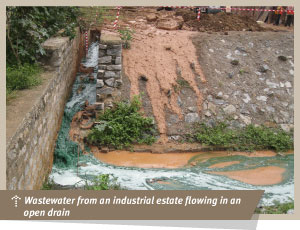 The first industrial parks began to be constructed with the aim of creating a space where industry could be removed from population centers, where there was good access to transportation and infrastructure, but also where the number of industries in one area could create economies of scale for high-quality waste treatment and disposal infrastructures. In the past forty years, the number of industrial parks has grown rapidly, with one study from 1999 estimating over 12,000 worldwide18. Almost every country in the world has some kind of industrial estate, with Vietnam and Sri Lanka estimated to each have 50 to 60 industrial areas, and India and China reaching hundreds of industrial clusters. Each industrial park is different in terms of the types of industries present and the size of the area, with some estates having room for hundreds of separate factories.
The first industrial parks began to be constructed with the aim of creating a space where industry could be removed from population centers, where there was good access to transportation and infrastructure, but also where the number of industries in one area could create economies of scale for high-quality waste treatment and disposal infrastructures. In the past forty years, the number of industrial parks has grown rapidly, with one study from 1999 estimating over 12,000 worldwide18. Almost every country in the world has some kind of industrial estate, with Vietnam and Sri Lanka estimated to each have 50 to 60 industrial areas, and India and China reaching hundreds of industrial clusters. Each industrial park is different in terms of the types of industries present and the size of the area, with some estates having room for hundreds of separate factories.

Most high-income countries have strict regulations and codes for their industrial estates, but in some low- and middle-income countries, little is done to protect surrounding communities from the waste and byproduct of these concentrated industries. South Asia and Africa, for example, have large-scale problems with lead contamination of groundwater systems by untreated effluent. The Blacksmith inventory has documented twenty-nine sites in these regions, and twelve in Southeast Asia, where industrial estates are releasing large amounts of lead contamination into the surrounding environment – which often means into an adjacent residential neighborhood. The inventory estimates that these sites alone impact close to 3 million people.
Exposure Pathways
Due to the diverse industries within industrial estates that may cause lead contamination, there are a number of different ways that toxins can enter the environment and can come into contact with people. Lead smelting and casting, and manufacturing of lead compounds – or other industries that require the heating of lead or objects containing lead – can release lead toxins into the air, where they can travel long distances and can contaminate soil, surface water, and food when they settle back to earth. Lead can remain in topsoil for many years, and can easily be spread as lead dust or tracked into homes or neighborhoods on shoes and clothing. Lead in soil can also contaminate crops and livestock, and can easily make its way into surface and groundwater systems.
Other industries that use lead in their production processes, such as paint and lead-acid battery manufacturing, can contaminate the environment through untreated, toxic effluent that is sometimes released directly into nearby water systems or is dumped on the ground where contaminants can leach into soil and groundwater. Of the sites listed in the Blacksmith inventory, the most common pathway of lead poisoning due to industrial estates is through the contamination of drinking water for surrounding communities.
Health Effects
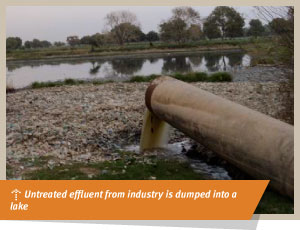 The health effects of exposure to lead can be both acute and chronic, and the problems caused by lead poisoning are particularly dangerous and severe for children. Acute lead poisoning can happen immediately and is often caused by inhaling large quantities of lead dust or fumes in the air. Chronic lead poisoning, however, occurs over longer periods of time and can result from very low-level, but constant, exposure to lead. Chronic poisoning is far more common than acute exposure and can be caused by persistent inhaling or ingestion of lead, or, over much longer periods, can result in lead accumulation in the bones.
The health effects of exposure to lead can be both acute and chronic, and the problems caused by lead poisoning are particularly dangerous and severe for children. Acute lead poisoning can happen immediately and is often caused by inhaling large quantities of lead dust or fumes in the air. Chronic lead poisoning, however, occurs over longer periods of time and can result from very low-level, but constant, exposure to lead. Chronic poisoning is far more common than acute exposure and can be caused by persistent inhaling or ingestion of lead, or, over much longer periods, can result in lead accumulation in the bones.
Health problems associated with lead poisoning can include reduced IQ, anemia, neurological damage, physical growth impairments, nerve disorders, pain and aching in muscles and bones, memory loss, kidney disorders, retardation, tiredness and headaches, and lead colic, which impacts the abdomen19. Severe exposure to high concentrations of lead can lead to dire health risks, including seizures, delirium, coma, and in some cases, death.
Neurological damage is especially pronounced in children suffering from lead exposure, with even small amounts of lead poisoning capable of causing lifelong developmental and cognitive problems. Exposure to lead in utero can also cause birth defects.
What is Being Done
Due to the scale and variety of industries, addressing pollution problems from industrial estates can be a challenging task. The key interventions in this area involve working with local governments, NGOs, and industry leaders to improve the levels of control, treatment facilities, and health and safety management at the estates. Successful examples of these kinds of programs involve strong leadership from international companies to adhere to global standards. In addition to leadership and effective management, industrial estates must also have the proper finances in order to upgrade to environmentally safe equipment. Proper enforcement of environmental and health standards, however, needs adequate political support, and buffering cooperation between government and industry can lead to improvements in these areas.
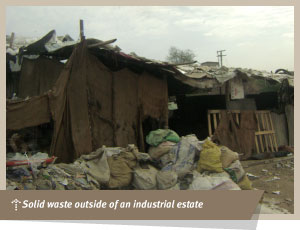 Example – DALY Calculations
Example – DALY Calculations
The Malir River, which runs through Karachi in Pakistan, is contaminated with high levels of lead due to indiscriminate dumping of untreated wastewater from industrial activity. The water is used for a variety of purposes, including irrigation of crops. Samples of the river found 2,170 parts per billion of lead in the water, a level that is 100 times the health standard for irrigation water. Blacksmith estimates that 20,000 people living near the river are at risk of health problems caused by exposure to lead.
DALYs associated with adverse health impacts from lead exposure are estimated to be 479,186 for the estimated population of 20,000. Thus, the 20,000 affected people will have 56,407 years lost due to death, or impacted by disease or disability. This would come out to approximately 23.9 years lost or lived with a disability per person. This high number is possible due to the number of children who are potentially at risk of spending a significant portion of their lives living with irreversible disabilities caused by lead exposure.
Footnotes:
[16]:“Environmental Guidelines for Industrial Estates.” Multilateral Investment Guarantee Agency, World Bank. Available at: http://www.miga.org/documents/IndustrialEstates.pdf.
[17]: “Lead: When are you most at risk?” Health and Safety Executive. Accessed on August 30, 2011. Available at: http://www.hse.gov.uk/lead/mostatrisk.htm.
[18]: Falcke, Caj O., Ph.D. “Industrial Parks Principles and Practice.” Journal of Economic Cooperation Among Islamic Countries, Vol. 20, No. 1 (1999): 1-10.
[19]: “New Basel guidelines to improve recycling of old batteries.” United Nations Environment Programme. May 22, 2002. Available at: http://www.unep.org/Documents.Multilingual/Default.asp?DocumentID=248&ArticleID=3069&I=en.

-
Artisanal Gold Mining
Mercury Pollution
-
Industrial Estates
Lead Pollution
-
Agricultural Production
Pesticide Pollution
-
Lead Smelting
Lead Pollution
-
Tannery Operations
Chromium Pollution
-
Mining and Ore Processing
Mercury Pollution
-
Mining and Ore Processing
Lead Pollution
-
Lead-Acid Battery Recycling
Lead Pollution
-
Arsenic in Groundwater
Arsenic Pollution
-
Pesticide Manufacturing and Storage
Pesticide Pollution
-
The Rest of the Toxic Twenty



